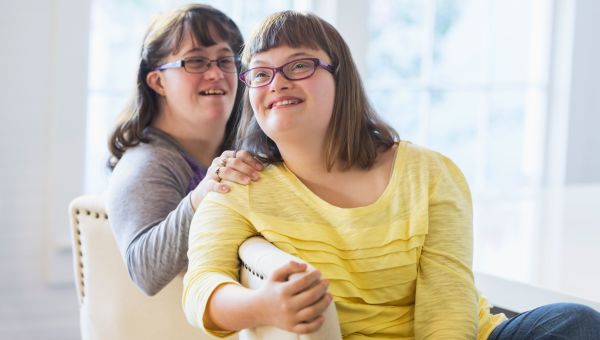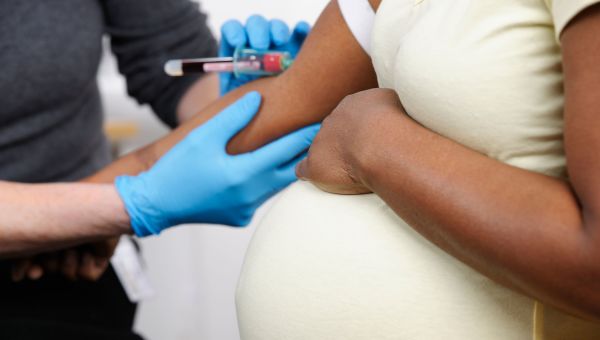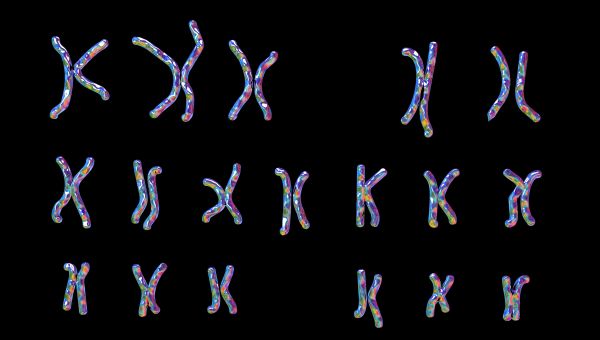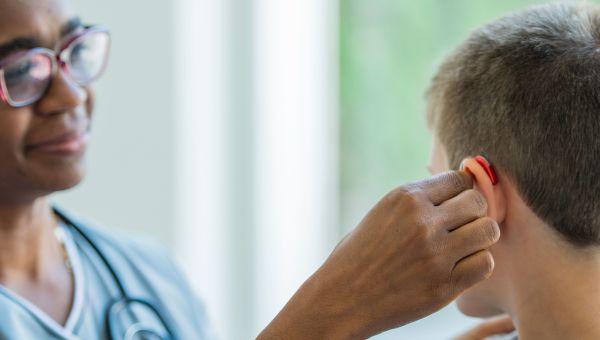7 things you should know about Down syndrome
About 1 in every 700 babies in the US is born with this chromosomal disorder every year.

Every year, nearly 6,000 new babies are diagnosed with Down syndrome, the most common type of chromosomal disorder. And although it can cause many developmental challenges, life expectancy for people with the condition has leapt from 25 years old in 1983 to 60 today.
What is Down syndrome? Typically, a baby is born with 46 chromosomes, or “packages” of genes. In the most… Show More
Every year, nearly 6,000 new babies are diagnosed with Down syndrome, the most common type of chromosomal disorder. And although it can cause many developmental challenges, life expectancy for people with the condition has leapt from 25 years old in 1983 to 60 today.
What is Down syndrome? Typically, a baby is born with 46 chromosomes, or “packages” of genes. In the most common form of Down syndrome, a baby has an extra duplicate, otherwise known as a “trisomy,” of chromosome 21. This affects their development, both mentally and physically; children with Down syndrome often have cognitive and communication impairments, as well as delays in motor skills, in addition to shorter necks and smaller ears, among other traits.
Whether you’re a soon-to-be-parent or you know someone with Down syndrome, here’s everything you need to know about symptoms, risk factors, screening options and more.
Show Less
Pregnant women have screening options
The American College of Obstetrics and Gynecology now suggests all pregnant women be given the option of Down syndrome screening tests in addition to a more invasive diagnostic test; screening tests determine the odds of having the condition, while diagnostic tests actually detect it. All testing… Show More
The American College of Obstetrics and Gynecology now suggests all pregnant women be given the option of Down syndrome screening tests in addition to a more invasive diagnostic test; screening tests determine the odds of having the condition, while diagnostic tests actually detect it. All testing is optional, and a personal choice that should be discussed with your OBGYN.
Screenings are typically done in the first 22 weeks, and most involve blood tests. There are a variety of options, including:
The triple screen or quadruple screen: This test measures the high and low quantities of alpha-fetoprotein, a protein generated by the fetus; irregular levels of human chorionic gonadotropin, a hormone produced in the placenta; and estriol, a type of estrogen that is made by the placenta and fetus.
Integrated screen: These screening results take into account blood tests and ultrasounds from the first trimester, and a quadruple screening from the second trimester.
Cell free DNA: This test screens the fetal DNA in the mother’s blood and is only offered to pregnant women who have an increased risk of having a baby with Down syndrome or other genetic condition.
Nuchal translucency testing: This looks for any fluid in the clear space behind the baby’s neck. These results, along with a mother’s age and baby’s gestational age, are used together to determine the risk of Down syndrome.
A “genetic sonogram”: In addition to blood tests, a high-tech ultrasound is used to examine the fetus for any abnormal traits connected to Down syndrome.
Show Less
There are diagnostic testing options, too
Diagnostic tests are 99 percent effective in identifying Down syndrome and other chromosomal irregularities, but they pose the risk of miscarriage and additional complications, since procedures are done inside the uterus. Some couples opt for these tests if they have a family history of genetic… Show More
Diagnostic tests are 99 percent effective in identifying Down syndrome and other chromosomal irregularities, but they pose the risk of miscarriage and additional complications, since procedures are done inside the uterus. Some couples opt for these tests if they have a family history of genetic issues, they’ve had an abnormal screening test or they just want to be sure. These tests can determine the type of Down syndrome, as well.
- Chorionic villus sampling (CVS) is the sampling of placenta through the cervix or abdomen, done 10 to 13 weeks into gestation. CVS can determine the presence of chromosomal abnormalities or genetic disorders.
- During an amniocentesis, a small needle is inserted into the uterus to obtain a sample of amniotic fluid; it's done around 20 weeks. Doctors will look for chromosomal abnormalities, neural tube defects or genetic disorders, such as cystic fibrosis.
- Percutaneous umbilical cord blood sampling, or cordocentesis, are samplings of blood from the umbilical cord taken around 18 weeks. These samples are used to detect chromosomal defects or abnormalities.
If families pass on any of the screening or diagnostic testing during pregnancy and their child shows symptoms of Down syndrome after birth, the child’s chromosomes can be analyzed to confirm the diagnosis.
Show Less
Lifestyle changes will not lower the risk of Down syndrome
Because Down syndrome is a genetic condition, it cannot be prevented. Babies with Down syndrome get an extra chromosome 21 at conception.
Experts don’t know why this duplication occurs. However, scientists have found that women who have a baby when they are 35 or older may have an increased risk.… Show More
Because Down syndrome is a genetic condition, it cannot be prevented. Babies with Down syndrome get an extra chromosome 21 at conception.
Experts don’t know why this duplication occurs. However, scientists have found that women who have a baby when they are 35 or older may have an increased risk. According to current research, there are no known lifestyle factors that increase the likelihood of Down syndrome, and the extra chromosome can originate from the mother or the father.
Show Less
Certain features are characteristic to Downs
Every child with Down syndrome develops and progresses differently, but there are certain traits common to all. Those with the condition tend to have a lower IQ than those who don’t have it, and their speech development may be slowed, as well.
Certain physical characteristics are also very common… Show More
Every child with Down syndrome develops and progresses differently, but there are certain traits common to all. Those with the condition tend to have a lower IQ than those who don’t have it, and their speech development may be slowed, as well.
Certain physical characteristics are also very common in children with Down syndrome. These include:
- Flattened facial features
- Almond shaped eyes that slant upwards
- A shorter neck
- Small ears
- A tongue that hangs out of the mouth
- White spots on the colored portion of the eye
- Small hands, pinky fingers and feet
- Line across the palm of the hand
- Weak muscle tone or looser joints
- Shorter in height
These qualities can be mild to extreme, depending on the child.
Show Less
There are different types of Down syndrome
Despite similarities between people with Down syndrome, there are different types of the condition. Trisomy 21 is by far the most common, affecting around 95 percent of those with Down syndrome. It means they have three copies of chromosome 21 instead of the typical two.
Other types include… Show More
Despite similarities between people with Down syndrome, there are different types of the condition. Trisomy 21 is by far the most common, affecting around 95 percent of those with Down syndrome. It means they have three copies of chromosome 21 instead of the typical two.
Other types include Translocation Down syndrome, which occurs when chromosome 21 is attached to another chromosome, and Mosaic Down syndrome, which means some cells have three copies of chromosome 21 and some have two.
Because the physical and behavioral symptoms are comparable, the only way to know which type a child has is to test the chromosomes using a karyotype. After birth, your child’s doctor will take a blood sample and examine the chromosomes more closely, grouping them by size, number and shape. A fluorescence in situ hybridization test during pregnancy is another option that’s similar,but provides faster results since cells don’t have to be grown in a lab.
Show Less
There’s an increased risk of other conditions
Although not all people with Down syndrome have other health conditions, it does increase the risk of certain medical problems. Hearing loss is extremely common—up to 80 percent of children with Down syndrome will experience some type of auditory problem, which can contribute to speech, development… Show More
Although not all people with Down syndrome have other health conditions, it does increase the risk of certain medical problems. Hearing loss is extremely common—up to 80 percent of children with Down syndrome will experience some type of auditory problem, which can contribute to speech, development and learning issues. And, almost half of children born with Down syndrome also have some type of congenital heart defect that may require surgery as an infant.
Other health conditions that can arise, in childhood or adulthood, include:
- Vision problems
- Weakened immune system
- Blood disorders such as leukemia, anemia or polycythemia
- Weakened muscle tone and spinal problems
- Sleep disorders
- Dental problems
- Epilepsy
- Digestive issues and Celiac disease
- Mental and emotional problems such as depression and anxiety
Those with Down syndrome may also experience a deterioration of mental ability as they get older, often beginning around the age of 50.
The severity of these conditions vary from person to person, and most can be managed with medication, surgery or other treatments.
Show Less
A diagnosis can make a family stronger
Though Down syndrome is a serious condition, many families find having a loved one with the disorder brings them closer together in ways they'd never imagined.
One comprehensive study reviewed surveys from nearly 2,000 parents or guardians of children with Down syndrome, 761 siblings of people with… Show More
Though Down syndrome is a serious condition, many families find having a loved one with the disorder brings them closer together in ways they'd never imagined.
One comprehensive study reviewed surveys from nearly 2,000 parents or guardians of children with Down syndrome, 761 siblings of people with Down syndrome and 283 people who had Down syndrome themselves. These findings showed that even though many of the families faced significant challenges in their day-to-day lives, they had positive attitudes. Family members were proud of their families and kept in good spirits, even through the tough times.
If you or someone you know has a child with Down syndrome, head to the National Down Syndrome Society for more information; you can learn how to help your family adjust, connect with other local families, participate in a caregiving webinar series, read inspirational stories and much more.
Show LessMore On


video

article

slideshow


video


video
